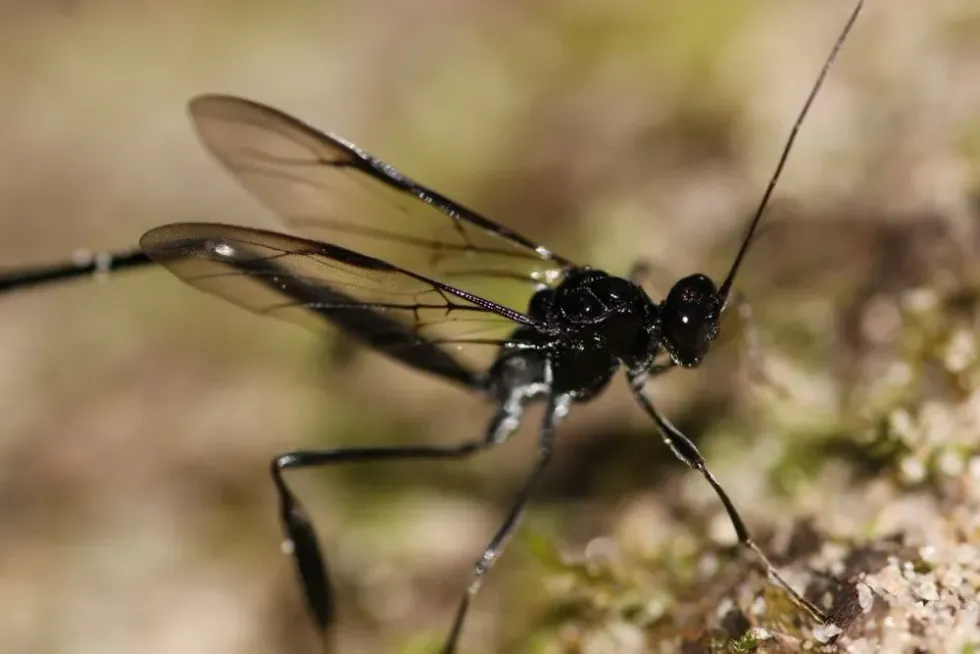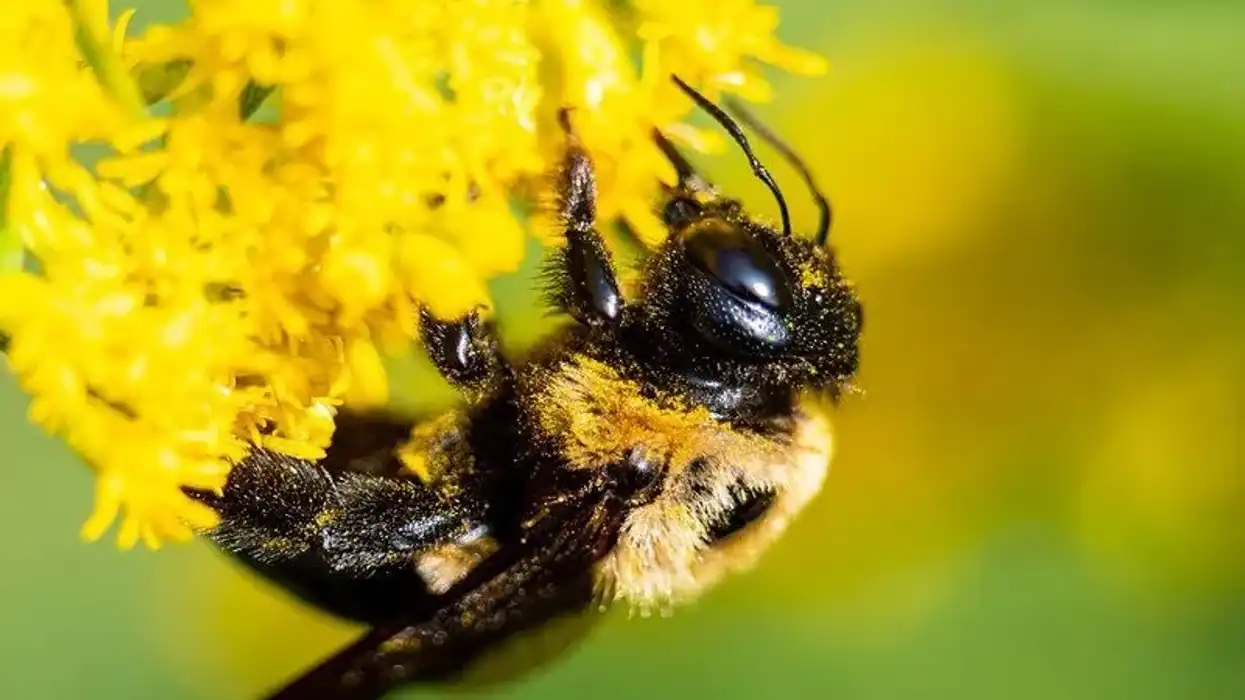The American pelecinid wasp of the Pelecinus genus is the only species under this genus. It is a very unique creature found in nature and has some very distinct features.
A large number of these pelecinids are found in forests as well as in city parks and gardens, making them one of the most commonly visible American wasps. American pelecinids are endemic to North, Central, and South America.
American pelecinids do not necessarily need a partner to reproduce. This type of reproduction is relatively more common in the northern crowd than those found in the southern and central parts of their range.
Some pelecinids can lay eggs on their own by the process of parthenogenesis. Before laying the eggs, the female wasp searches for beetle grubs located underground by descending on the ground or flying very slowly, closer to the ground with a curled abdomen.
The curled abdomen is exceptionally long and narrow in the females. Although it resembles a stinger, this is a misconception as pelecinids do not actually sting.
If you are interested in wanting to know more about the American pelecinid wasp, keep reading these amazing facts. For similar content, check out mud dauber wasp and yellow jacket wasp facts too.
American Pelecinid Wasp Interesting Facts
What type of animal is an American pelecinid wasp?
The American pelecinid wasp (Pelecinus polyturator) is a type of parasitoid wasp. They are the most common wasp of the family Pelecinidae.
What class of animal does an American pelecinid wasp belong to?
The American pelecinid wasp (Pelecinus polyturator) of order Hymenoptera and genus Pelecinus belongs to the class Insecta, the common class for all insects.
How many American pelecinid wasps are there in the world?
The global population of the species of American pelecinids is not known. It is difficult to calculate the populations of these insects accurately as they cover a large range. However, it is believed that American pelecinids are the most commonly visible among all other species of the pelecinid wasp. This insect species is heavily distributed throughout America.
Where does an American pelecinid wasp live?
The species of American pelecinid wasp has been distributed over a a wide range in north, central, and South America. In the north, they occur in large numbers to the east of the Rocky Mountains.
The species also are spotted in southern Canada and parts of Southwestern USA. In the south, they can be traced from Argentina up to the USA and Canada.
What is an American pelecinid wasp's habitat?
American pelecinid wasps are found in large numbers on the forest floor at the onset of the summer months. The insect occurs widely in open fields and forest edges, especially deciduous forests. They also inhabit grasslands, woodlands, and gardens mainly to feed on flowers and nectar. They tend to stay closer to the surrounding ground even when flying.
Who does the American pelecinid wasp live with?
During parthenogenesis, females lay only one egg on June beetles. The larva that comes out of the eggs stays with the hosts until it pupates itself and finally emerges as an adult.
As a result, American pelecinids are assumed to live solitary life since the beginning of their life cycle. However, in the south, adults may come closer to each other during breeding.
How long does an American pelecinid wasp live?
Currently, there is no information regarding the lifespan of these pelecinids. It is believed they could live a very short life like other wasps like horntail wasps, or they might live longer.
How do they reproduce?
In the north, adult males are extremely rare. The female population exceeds the population of males by a lot. This means females resort to reproducing through parthenogenesis.
In this method, females lay only one egg on a single grub, preferably on June beetle grubs. On detecting the presence of beetle grubs, the female will insert her abdomen and lay one egg on the June beetle. These grubs act as hosts to the larva.
In the southern and central populations, reproduction occurs normally between a male and a female wasp. American pelecinid larvae feed on June beetles as soon as they come out of the egg.
After consuming the host entirely as their only source of food, the larva quickly pupates itself. Generally, adults emerge from the larvae in the summer and continue until September when winter sets in.
What is their conservation status?
Currently, American pelecinid wasps of the Pelecinidae family do not fall under any category in the IUCN Red List. Their global populations have a status of Not Evaluated currently.
The wasp and its larva are fairly common throughout their range. This easily proves that they are more or less found in abundance with very little chance of extinction in the near future.
American Pelecinid Wasp Fun Facts
What does an American pelecinid wasp look like?
The American pelecinid wasp is a slender and glossy wasp found throughout the United States and Canada. They have long, narrow, and slender bodies and a long tail that resembles a stinger.
This tail is longer in the females than the males. In reality, this stinger like body part is actually the abdomen of the wasp. In males, the abdomen is much smaller with swollen tips.
Males also have glossy bodies and bulged legs like the female species. However, the hind legs of the females are much larger than those of the males.
How cute are they?
Most people are scared by the presence of this all black wasp and cannot be considered to be cute.
How do they communicate?
Like all other insects, pelecinid wasps do not communicate by making sounds. They use the sense of smell and chemical emission to communicate with each other.
How big is an American pelecinid wasp?
The length of the body of an American pelecinid wasp can be up to 2.5 in (7 cm). They are around two times larger than normal wasps, like the great black wasp.
How fast can an American pelecinid wasp fly?
We don't know the actual flying speed of these insects. The only thing known about their flying pattern is that they generally fly at very low heights, close to the ground.
How much does an American pelecinid wasp weigh?
The weight of an American pelecinid wasp has not been determined. Almost all species of wasps, including the European paper wasp, weigh very light.
What are the male and female names of the species?
The male and female species do not have any specific names. However, in the wasp community, males are called drones and infertile females are referred to as workers.
What would you call a baby American pelecinid wasp?
In the early stage, wasps are called larvae.
What do they eat?
American pelecinid larvae only consume their host grub and as they grow up, their food habit changes. The adult wasp feeds on flower pollen and drinks water and nectar.
Are they poisonous?
No, they are not poisonous. This wasp's curled abdomen looks like a stinger, however it does not actually sting.
Would they make a good pet?
No, these insects do not make good pets.
Did you know...
The stinger like abdomen in the female wasp is five times the actual size of the pelecinid's body. It helps to poke the soil and search for a grub underground for laying eggs. After hatching, the wasp larvae feed on the host grub.
How many eggs do American pelecinid wasp lay?
American pelecinids of the north do not perform sexual reproduction. The female pelecinid of the north lays a single unfertilized egg on the host grub. The number of eggs laid by the southern species is unknown.
Can a pelecinid wasp sting you?
Female pelecinids have an extremely long abdomen that may look like a stinger, but actually, they do not sting. At the most, the thin and narrow abdomen can poke or push a threat away from a wasp.
Here at Kidadl, we have carefully created lots of interesting family friendly animal facts for everyone to discover! Learn more about some other arthropods from our flatworms facts and centipede facts pages.
You can even occupy yourself at home by coloring in one of our free printable wasp coloring pages.









